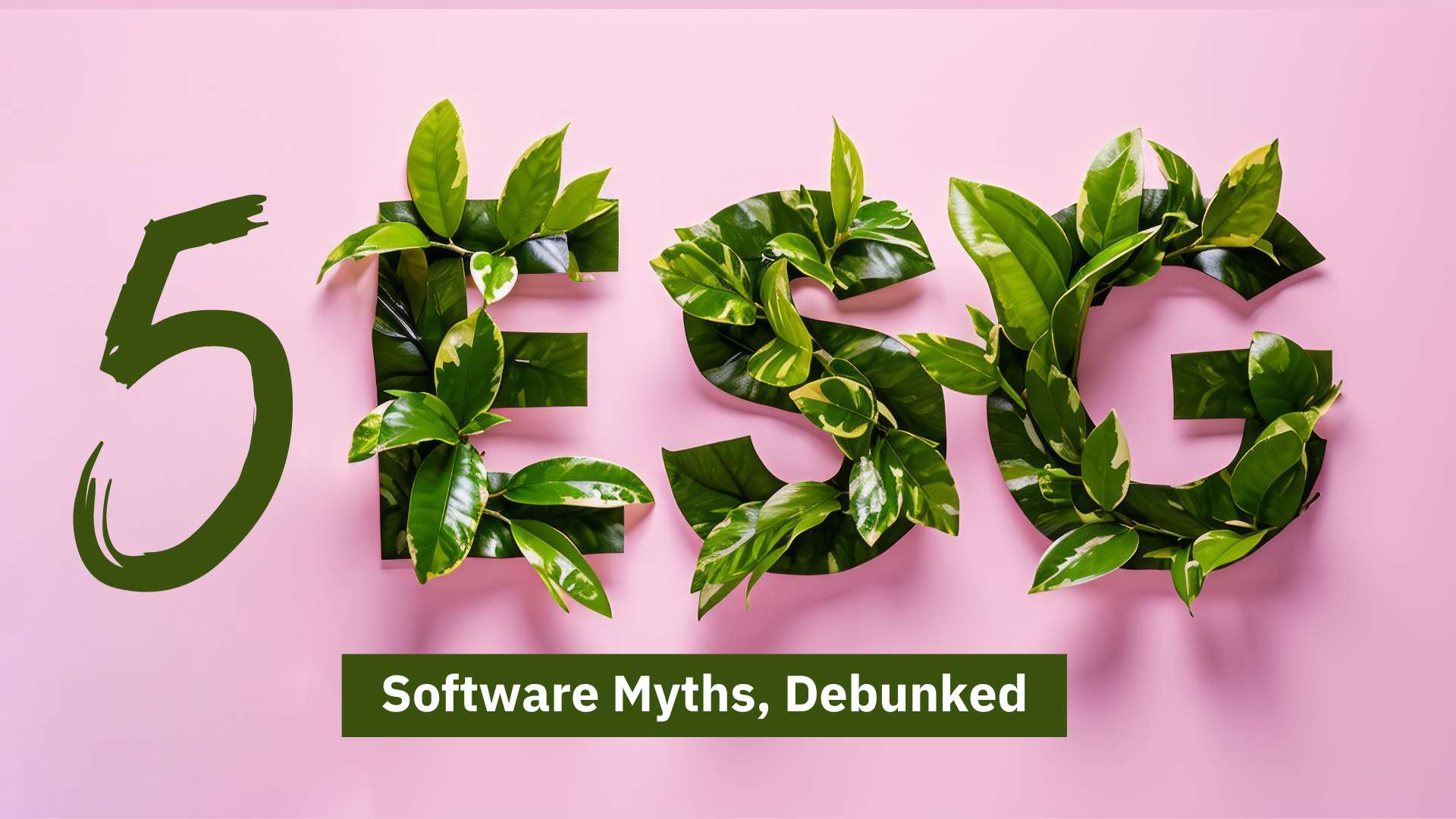Operational efficiency never goes out of style, even when politics, regulatory requirements, or even direct climate change impacts influence business decisions. Being efficient is simply a good business practice, as its cost savings demonstrate smart business choices.
In business sustainability, ESG data is the main currency investors and regulators use to draw comparisons and reach conclusions about companies, assets, and projects. Efficiency can drive the results in the ESG data that investors and other stakeholders are looking for. The most practical way to collect this data is using ESG software.
It offers a user-friendly experience centered on the core aims of sustainability management and reporting. Many companies are looking for ESG software solutions to reduce their workload, but the decision can be overwhelming. They might stall their decision for different reasons and resort to spreadsheets as a stopgap. Yet, spreadsheets require extensive set-up to ensure ESG data is processed accurately, leaving a lot of room for error. Here are some things to debunk a few common ESG software uncertainties.
Myth #1: There’s no business case for investing in ESG Software
When viewed in isolation from broader sustainability and business goals, the task of collecting sustainability data with ESG Software may seem redundant by duplicating the work of meters, utilities receipts or other forms of data that a business tracks. However, a sea of meter readings and receipts will never tell a good story. The underlying point of ESG data collection and reporting is to gain insights and communicate business value.
It’s important to look at the bigger picture to understand four critical ways this seemingly menial task can unlock serious value. The same way profitable business is not all about entering transactions in the balance sheet, the sustainability journey isn’t just about measuring and reporting data. However, data collection is an essential step to achieving or demonstrating any of the other benefits associated with a sustainability project.

In order to establish a baseline for goal setting, you’ll need data. Goal-setting drives internal awareness about the potential for project ROI. Clearly communicating goals can motivate employees to achieve the necessary targets to demonstrate value creation. With sustainability, value is never simply the direct cost reduction reported on the balance sheet. These reductions can also bring lowered business risk, innovation and positive responses from customers and employees who share an interest in the business sustainability goals.
Let’s say you want to bring down the energy use of a building by 15% in the next two years. Without the underlying data, you won’t know if this is a viable goal, where to find low-hanging fruit for achieving this goal, or where the energy pinch points are. It could be that your operations run 24/7, and your energy demand is fairly constant. Alternatively, it could be that certain systems or equipment drain energy because they don’t have automatic shut-off features. These details only become clear when you start analyzing the data. The key point is that a strong data collection system unveils these insights. Atrius Sustainability is a powerful tool for exactly this purpose.
Myth #2: Sustainability software is too expensive
An alarmingly high number of public companies use Excel for ESG data collection, tracking, and monitoring, according to responses in a 2022 EY survey. This suggests they don’t see the value of investing in specialized software or they haven’t had the time and/or resources to make the move yet. Meanwhile, companies using Excel lose time while setting up a custom system that not only lacks suitability to the task, it can corrupt the data from user error.
The time spent using basic spreadsheets can be far more costly than a monthly or yearly subscription to a dedicated software solution. Managers responsible for tracking and monitoring the data probably have much better uses of their time.
Sustainability reporting requires consistent and comparable year-over-year data. Just to report on greenhouse gas emissions, you’ll need to map the emissions sources by scope and type, input gas and electricity purchase receipts, properly reflect building infrastructure, avoid double reporting of emissions for complex metering arrangements, assign carbon emissions factors to different data inputs and report on the data in specific formats for different sustainability frameworks, benchmarks and/or regulatory requirements.
Atrius Sustainability streamlines this work by embedding useful categories, emissions factors, and data fields specifically for high-quality reporting of information related to emissions, energy, water, waste, biodiversity, and more. All of the components used for tracking and monitoring environmental resource data are housed in a central location that’s robust enough to grow with your business. The following features all save time, both during set-up and throughout the data management process:
- Integrations for data inputs
- Reporting automation
- Project tracking
- Calculation of carbon emissions
Contextual information often required in reported disclosures, such as measurement methodologies, measurement metrics, project or business boundaries, and changes made to assets or systems, is all housed in the software. Given the time savings, using Atrius significantly reduces the time and learning curve needed to house sustainability data effectively.
Myth #3: You need to either be an expert to use sustainability software or incur more costs
For businesses with a lean sustainability strategy, environmental sustainability responsibilities may be distributed to professionals without dedicated expertise or practical experience in these areas. The benefit of using Atrius sustainability is its user-friendly design can reduce the workload and mental exhaustion needed to develop relevant expertise.
Sustainability standards-aligned strategies for inputting data are apparent from the design of the software. We emphasized ease of onboarding while developing the platform because this is the most time-intensive part of setting up a sustainability software.
To ensure this phase of using Atrius Sustainability is stress-free, we provide customer success manager support for walking customers through set-up. This comes at no added cost to users since setting up our software is part of our package. Our helpful staff is trained in identifying the most straightforward path to align the software’s automations and integrations to your business model. In addition, our extensive learning support hub offers step-by-step troubleshooting guides for each feature of the platform.

Myth #4: There are too many sustainability software solutions to choose from
The number of ESG software tools is growing rapidly, and many vary in purpose and function. Knowing what to look for in the right tool is critical. ESG software generally serves three main purposes – data management, reporting and disclosure, and improving operational performance. These are required for all of the three ESG themes: environmental, social and governance factors.
Finding the right software means identifying the specific areas your teams lack management systems for. Atrius Sustainability is especially useful across the environmental pillar of sustainability, as we provide data management across the main reporting categories for environmental sustainability: emissions, energy, water, waste, and biodiversity. In fact, Atrius Sustainability covers all three of the main functions of ESG software:
- Centralized data management
- Outputs aligned with standard reporting formats and requirements with a traceable audit-trail that improves the likelihood of successful assurance
- Operational performance improvements through strong data visualization and project-level data collection
For carbon accounting, our platform is an essential resource for medium-sized businesses that need an affordable yet robust tool. Beyond these core platform functions, we also have a suite of other applications that support building facilities maintenance, improvements, and energy management needs specifically useful to companies owning, managing and/or leasing multiple buildings. Identifying the core needs for your sustainability management goals will lead you to the right ESG software.
Myth #5: We still have plenty of time to choose a sustainability data platform in the future
In recent years, a rapid increase in mandatory ESG reporting requirements has taken place. The EU’s Corporate Sustainability Reporting Directive (CSRD) may seem irrelevant to businesses in the US, but is expected to have a global impact. Companies it applies to are expected to report across their entire value chains. Moreover, US subsidies in Europe that meet the reporting business size requirement, will have to align their reporting with CSRD.
For US businesses, the SEC has proposed its own climate-related disclosure requirement that is still pending. Though more concentrated on carbon emissions and related climate risks, this could soon create mandatory reporting requirements affecting publicly listed companies.
California has created its own climate-related reporting requirements for large public and private companies doing business in the state.
It’s very likely these requirements will affect businesses outside the reporting scope, so now is a good time to prepare for the changes. These companies will need to access carbon accounting data from their suppliers as well to meet their Scope 3 emissions reporting requirements. Fortunately for suppliers and small- to medium-sized enterprises, ESG software has become more affordable and effective than ever.
Atrius Sustainability provides one source of truth and centralizes your sustainability reporting to track goals, increase internal awareness, and drive ROI.



